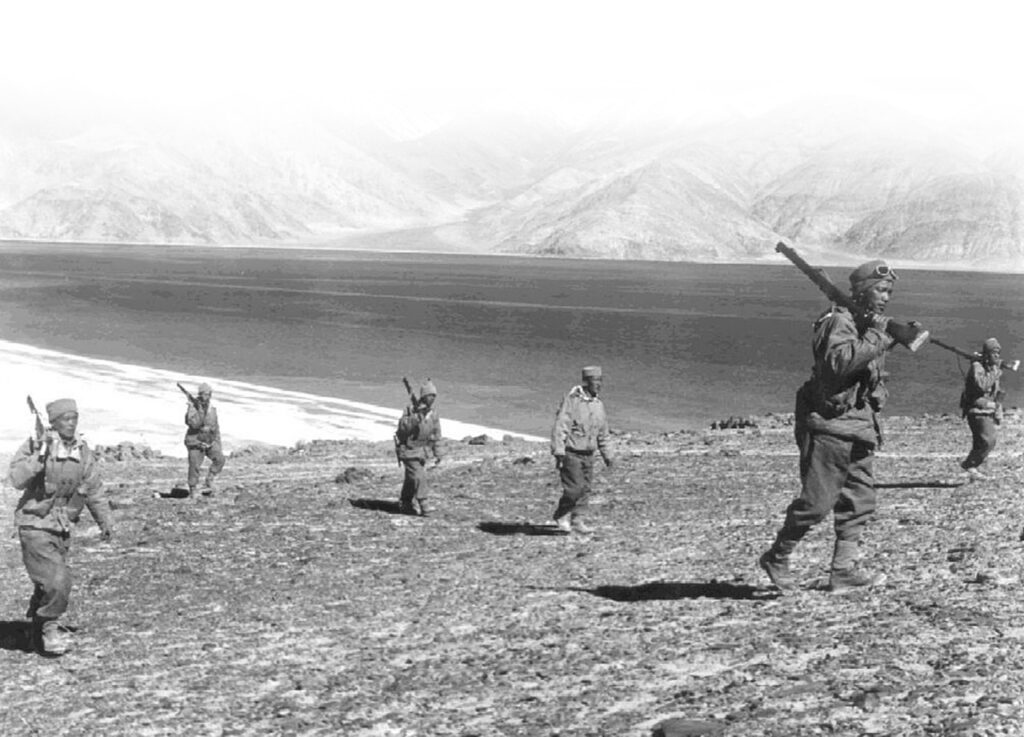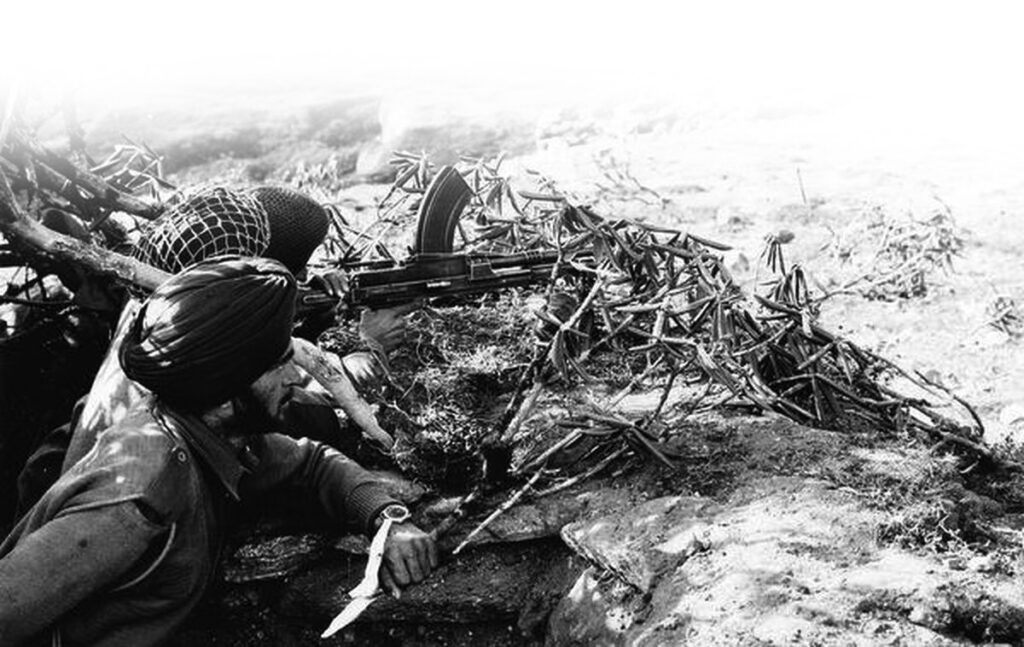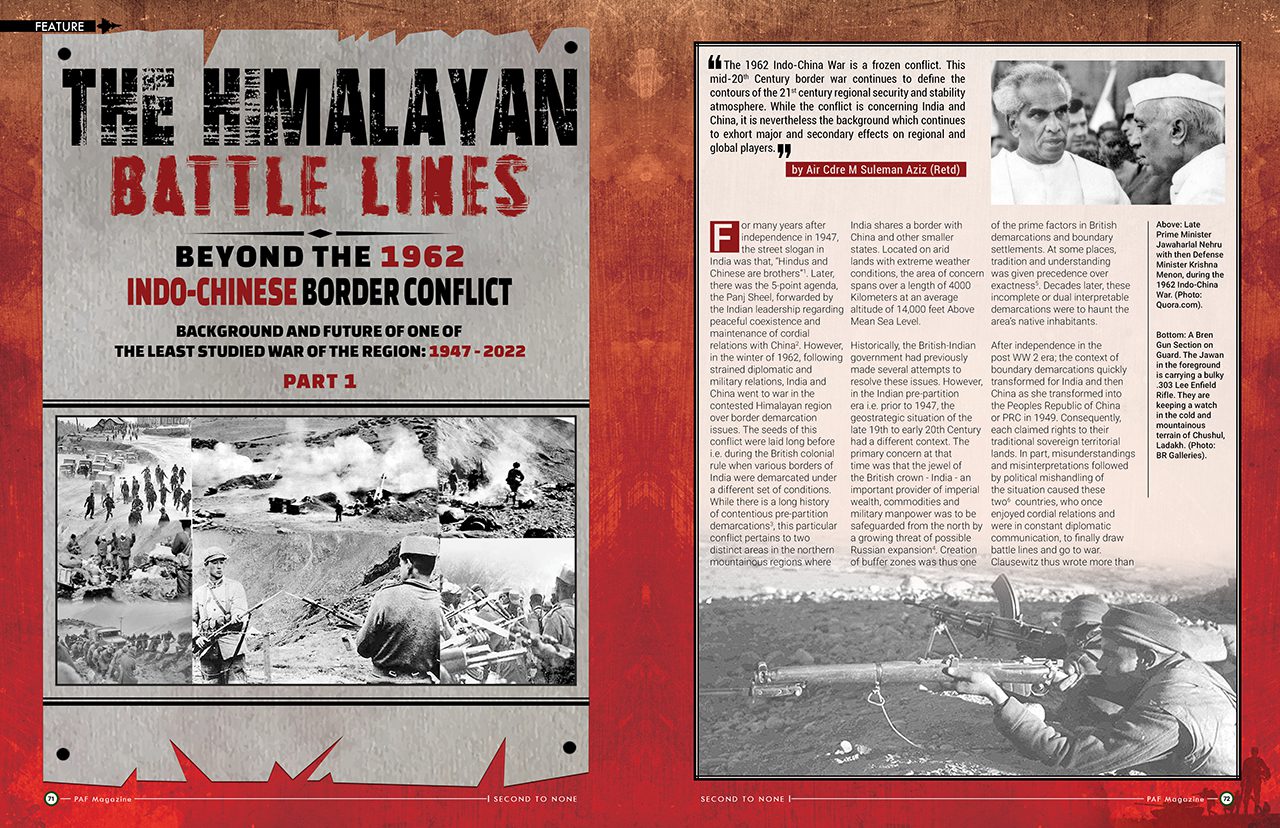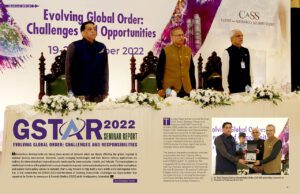Background and Future of One of the Least Studied War of the Region: 1947 – 2022 Part 1
The 1962 Indo-China War is a frozen conflict. This mid-20th Century border war continues to define the contours of the 21st century regional security and stability atmosphere. While the conflict is concerning India and China, it is nevertheless the background which continues to exhort major and secondary effects on regional and global players.
For many years after independence in 1947, the street slogan in India was that, “Hindus and Chinese are brothers”1. Later, there was the 5-point agenda, the Panj Sheel, forwarded by the Indian leadership regarding peaceful coexistence and maintenance of cordial relations with China2. However, in the winter of 1962, following strained diplomatic and military relations, India and China went to war in the contested Himalayan region over border demarcation issues. The seeds of this conflict were laid long before i.e. during the British colonial rule when various borders of India were demarcated under a different set of conditions. While there is a long history of contentious pre-partition demarcations3, this particular conflict pertains to two distinct areas in the northern mountainous regions where India shares a border with China and other smaller states. Located on arid lands with extreme weather conditions, the area of concern spans over a length of 4000 Kilometers at an average altitude of 14,000 feet Above Mean Sea Level.
Historically, the British-Indian government had previously made several attempts to resolve these issues. However, in the Indian pre-partition era i.e. prior to 1947, the geostrategic situation of the late 19th to early 20th Century had a different context. The primary concern at that time was that the jewel of the British crown – India – an important provider of imperial wealth, commodities and military manpower was to be safeguarded from the north by a growing threat of possible Russian expansion4. Creation of buffer zones was thus one of the prime factors in British demarcations and boundary settlements. At some places, tradition and understanding was given precedence over exactness5. Decades later, these incomplete or dual interpretable demarcations were to haunt the area’s native inhabitants.

After independence in the post WW 2 era; the context of boundary demarcations quickly transformed for India and then China as she transformed into the Peoples Republic of China or PRC in 1949. Consequently, each claimed rights to their traditional sovereign territorial lands. In part, misunderstandings and misinterpretations followed by political mishandling of the situation caused these two6 countries, who once enjoyed cordial relations and were in constant diplomatic communication, to finally draw battle lines and go to war. Clausewitz thus wrote more than 100 years ago, ‘it is clear that war is not a mere act of policy but a true political instrument, a continuation of political activity by other means’7.
What exactly happened from 1947 to 1962 is not just another war story from the books of military history. It laid down the context of the future security matrix for the South Asian region and beyond! Today, this region has the most rapidly rising economic and military powers of the 21st Century and is home to more than 2.5 billion people. While this conflict concerns two protagonists, as a consequence, few major and secondary effects are generated on other regional and global players. These continue to be a factor in the 21st Century – and for the foreseeable future.
As of today, the 1962 Indo-China war stands as a frozen conflict8. What can be drawn from the 1962 Indo-Chinese war in terms of regional stability? The answer to this question is not simple as it is a live and evolving situation. This simmering has not faded either. In fact, in 2020, there were renewed tensions in the same region. Due to the continuing applicability of its causes, it would be necessary to briefly narrate history of the problem, conditions leading up to the conflict and its outcome. This article will analyze the problem in its entirety following the single case study methodology. Then evaluate its impact on future relations between the two opponents in particular and other ‘concerned’ regional countries, with some applicable interpretations for Pakistan. While undertaking this analysis, it would be evident that from 1962 onwards, the two nations i.e. India and China, view each other with caution. There are momentary periods of border conflicts and rising tensions in an irregular sinusoidal sequence9. Furthermore, Indian drives to pose herself as a strong supporter of US policies in the US pivot-to-Asia-stategy adds to the impediments of resolving any issues. Indian aspirations can now be seen as it is a member of the Quadrilateral Security Dialogue or the ‘Quad’ involving USA, Japan and Australia. Although considered as a loose alliance focusing on security and economic interests, the four navies participated in their first joint exercise in over a decade in August, 2021, off the Guam islands in the Pacific under Exercise Malabar-2110. Whereas, Exercise Malabar-22 was conducted for over 5 days near Yokosuka, Japan in November and witnessed live weapon firings, anti-air and ASW drills besides other tactical and interoperability procedures of the four navies.

Consequently, the main structure of external security for the two protagonists, at least in the South Asian region and specifically in the context of the Indian defence policy has clearly been transformed. It would be clear as to why continued development of Indian military potential11, including its nuclear, space and guided missile programs12 and efforts to acquire aerospace force and blue water naval capabilities13 clearly link with her foreign policy. These in turn are also related in ways to the strained Indian relations with Pakistan, her other conflicting interests with China and her desire to attain regional power status. Hence, the Indian politico-military psyche, despite the bollywood projection and other soft image initiatives, is set at a threshold defined by the strong requirement to retain overall balance with a rising China14.
However, in this article, due to the vastness of the subject, multiple linked issues like details of the Indian rivalry with Pakistan and other Chinese disputes in the South or East China Sea’s would be briefly mentioned, only to provide an overview of the wider canvas of the future context of South Asian geostrategic concerns. Today, beyond the dawn of the 21st Century and hyper-connectivity of the globalized world, opportunities have revitalized intentions of China and India to sustain high economic growth. Even as there is realization that economic cooperation would be mutually beneficial, there is an additional factor i.e. competition for attaining or retaining strategic leadership – at least in the South Asian region.
Until the 2020 Galwan area border conflict15, both India and China could have been considered on the path of improving diplomatic and economic relations. After, the 2020 incident, the factor of ‘keeping an eye on each other’ with transient periods of tensions clearly continues to exist till date. Needless to emphasize, another military conflict between these two nuclear powers, could easily translate to adverse global and regional effects. Subsequently highlighted arguments explain their relations and reasons. As a final point, we will also briefly mention the consequent impact of 1962 Indo-Chinese war on global strategic bloc re-alignments in light of the on-going Russia-Ukraine confict and the readjustments that would affect global stability in the 21st Century. In conclusion, we would synthesize the main factors considered and attempt to rationally answer whether there is possibility of re-emerging tensions or improved relations between the India and China.
Historical Perspective of the Problem

The border war of 1962 with the ensuing rivalry and strategic competition between India and China is not limited to one incident. While the 1962 border war is the main event, there are a series of short skirmishes before and much later. As in many other cases, China is usually considered and portrayed as the aggressor – the Asian tiger that initiated this conflict as well.16 China is considered as the perpetrator as it must have supposedly initiated the conflict as a part of its traditional and ancient Chinese grand strategy to secure its near abroad or peripheral regions. However, Neville Maxwell, (India’s China War, Worcester and London, 1970) amongst others, in his epic work, ‘India’s China War’ has carried out in depth research and traces the background of this conflict. As the conflict stands unresolved till date, a short lesson in the context of geographical orientation is also necessary.
To this day, the conflict involves two separate areas on the approximately 4000 Kilometers northern border of India with China. First is the North Eastern Frontier Agency or NEFA, a former province of India. Now called Arunachal Pardesh and it borders with Bhutan (see map above). The northern boundary of this area is the disputed at the infamous McMahon Line.17 This line was used by the British to demarcate and separate China’s current autonomous Tibet region. This line was drawn after a formal treaty with the then independent Tibetan government in 1914 through another Simla agreement.18
The line was contested after independence and an independent Indian survey after 1947 did find some inconsistencies. However, Maxwell and others have gone into great length to explain the problem in its interpretation by the Indians19. This was primarily due to the traditional Indian comprehension and folklore that the summits of the Himalayan range separate India and China rather than other demarcated boundaries. While there are other minor inconsistencies in the actual border pillars marked in the pre-partition era by the British Army, these issues strongly came to limelight when India started publishing her own maps of this region in 1954. The actual McMahon line therefore exists South of Indian interpretations. The other contentious point for the Chinese till this date is the town of Tawang, located north of Assam, under Indian control and remains as one of the potential flash points of the future20.

The second disputed area is more than 1000 Km to the west of NEFA and is called Aksai Chin21 and few adjoining areas.
Both China and India lay claim to this land (it is under China now). Once again, Maxwell along with other sources explain at length, problems of Indian interpretations. In essence, the issue here goes further back to the 1840s when independent Sikh regiments i.e. of Indian princely states had conquered this area. However, these were evicted by the Chinese counterstroke and pushed back further down till present day Ladakh in India. The two fighting forces finally disengaged and a non-interference treaty was signed in 1842. Each force i.e. the Chinese and the Sikh regiments had a reason to disengage. The Chinese were involved in their first Opium war while British India was getting destabilized as it drew near the Anglo-Sikh tensions before the first war of independence or the mutiny of 1857.
To the Chinese therefore Aksai Chin was their land – as always22. In this case, the McDonald – McCartney line i.e. the 1865 British expedition to survey and demarcate this area from China was acceptable to the Chinese. India realized this only after Tibet was annexed by China in 1950 and a road was being subsequently built by them through this area from 1956-67.
The 1962 Border War
At the core of this event, it was not the demarcation or rejection of these lines that led to this war. The real problem lay in the handling of the situation from the Indian side. In that, history records Indian domestic political bickering and an extreme hard line stance adopted by the Indian government under Indian PM Nehru23. Initially after 1947, there were steadily growing relations between India and China. India was the 16th Country to recognize China and was a mediator and facilitator from the Chinese side in the resolution of the Korean conflict of the 1950s24. However, as the years passed and when problems of border demarcations came to light, there was no clear perusal of diplomatic claims or strategy to peacefully resolve the issue. The exception, quite like today, was the media fire and parliamentary rhetoric in India. Clarifications were not directly sought despite Chinese non-recognition of Indian maps printed in 195425 (which are since then taken as reference, specifically by the western countries).
Diplomatic miscommunication or inadequate communication or a combination of both soon led to a short skirmish in 1959 between Indian border patrols that were found beyond their territory in NEFA i.e. beyond the McMahon line while confronting Chinese frontier guards. Another skirmish occurred two months later in Aksai Chin26. In response, the Chinese strengthened their positions north of NEFA and initiated diplomatic efforts while consolidating their positions in Aksai Chin. However, the initial Chinese military re-deployments went largely unnoticed by India.

After the first skirmishes, Indian domestic portrayal of the situation was understandably of Chinese aggression. In the post Korean war era and height of the cold war, this view was obviously and very largely accepted by the west – as it would be today – in support of a democratic India rather than a communist China27. Strangely, while diplomatic communications continued, the skirmishes soon went into the background due to other domestic commitments in both countries. When the topic did revive, it arose strongly in Indian parliamentary debates. Domestic political blame-game with finger pointing and mud slinging between political opponents was responsible for the uproar and subsequent actions. Hence the Indian government of the time under PM Nehru came up with a plan to resolve the issue – once and for all!
Consequently, as the media and public debates on military skirmishes grew intense, soon it was a matter of internal drive i.e. by the Indian population – driven largely by the political opponents of the ruling Indian leadership – to militarily evict the Chinese31.
What followed subsequently actually aggravated the situation. In that, India adopted an aggressive stance that was subtly called its ‘forward policy’28. This was to militarily evict the aggressors from perceived Indian claimed territory with no further discussions unless there was a complete and unconditional Chinese withdrawal. The stance in itself was the perfect ingredient for a military conflict. Therefore, despite repeated Chinese requests, visits by PM Chou En Lai29 and numerous other diplomatic efforts, the Indian stance grew harder. Peace initiatives by other countries like Sri Lanka were also fruitless. The Indian Military at first did not support a conflict with China. Nevertheless, contrary to the facts and against the strategic appreciation by the Indian army, the Indian political leadership domestically portrayed India to be militarily in a stronger position and with better overall preparations. Moreover, it was the assessment of the political leadership; which was largely uncontested by the Indian army’s hierarchy; that China would not militarily respond to aggressive Indian patrols. This in essence was a critically incorrect military and strategic assessment that caused neither the government nor military leadership to adequately prepare for a Chinese response. This posture was also obviously converse to the Indian army field commanders’ views from the Himalayas30.
Therefore, during October – November 1962, Indian army forward patrols on encountering and engaging Chinese frontier guards initiated the spark for the border conflict32. After a brief lull in the fighting, what followed next was the systematic defeat of an ill prepared but numerically equivalent strength of Indian troops33. By the time the Indian political leadership and military hierarchy did accept the real ground situation and began emergency deployments with logistic moves, it was too little too late34. Despite all efforts, the conflict concluded with a humiliating defeat for India. As often, strategic miscommunication, operational misinformation and incorrect strategic appreciations do cause such results.

After achieving their objectives in Aksai Chin (Pinyin in Chineese language) and NEFA or Arunchal Pardesh areas, the Chinese ground forces unilaterally declared ceasefire and withdrew mostly to their pre-war positions. The war had lasted for about a month i.e. from 20 October to 20 November, 1962. Upon termination of operations, the Chinese leadership simultaneously exhorted the Indians to diplomatically resolve the issue while returning all Indian captured weapons and ammunition – something anagolous to a Kung Fu movie wherein the lead character retreats but only after teaching a life long lesson! Interestingly, there was no use of airpower by either side other than pre-war logistics drops and reconnaissance flights with the Indians continuously fearing repercussions of Chinese air force retaliation. There was no role for either navy in this war either and no assets were ever deployed. While there were numerous political and military errors at the strategic and operational levels, this was a scar on the Indian political leadership, military hierarchy and the public that was not to go away easily. In spirit, what the Chinese had adopted was a strategy that was militarily applied on them previously by the Russians35.
Through the years after 1962, no progress on any of the issues could ever be made specifically until the death of PM Nehru in 1964. Moreover, it was only later when public pressure into answers following tensions with Pakistan that the Indian government initiated an inquiry and began to look into the real reasons of the conflict and its outcome36. The official results of the war in terms of casualties were published by India in 1965 with approximately 5000-7000 Indian soldiers killed in action, depending upon the source, and many more casualties. The Chinese casualties were approximately one-tenth of these. Diplomatic relations between China and India actually never revived until 15 years later37. Between these years, there were a series of events and two more near engagements. Recently i.e. as of 2020, there has been another serious incident that highlights the reality of the issue. Nevertheless, other than these military centric events, there have been a series of political, diplomatic and economic aspects of this conflict that are essential to contemplate.
Indo-China Diplomatic and Economic Relations: Post 1962.

Barring occasional statements to denounce each other, there were no diplomatic relations between the two states until the end of 1970s. During this time period, the Indian stance remained unchanged from the legacy of Nehru and the Chinese retained their stance for diplomatically resolving the issue while maintaining forces at the pre-1962 war positions – a stance not followed in totality by India38. However, after the Indian elections of 1977, Indira Gandhi’s political party (daughter of Nehru) lost power. Consequently, power was transferred to a new leadership and political party in India – and a new thought process. Thus, efforts for reviving diplomatic relations were reinitiated by the end of 1978 when the Indian Minister for External Affairs visited China39. The build-up of relations was painfully slow as there were various tensions and military events in parallel (explained later) that would stall the process. Nonetheless, through the 1980s, there were reciprocal visits by the Chinese. Diplomacy prevailed throughout and thwarted military buildups in the north of India during the mid 1980s.

Nevertheless, after the end of the Cold War, the context of relations between the two started to change. The 1990s again witnessed reciprocal visits between the heads of the two states and border dispute resolution mechanisms were put in place. Occasional reminders by Indian leadership that China remains its prime enemy continued, such as after the Indian nuclear tests of 1998. The development of Indian long range ballistic missiles to reach major Chinese cities and other military capability enhancement measures are also in the same context. These developments involving Billions of US $ in an otherwise third world country clearly indicate that despite steady improvements in relations at diplomatic level, the 1962 conflict has played a major role in promoting instability in the region. Moreover, relatively recent Indian initiatives to remain enthusiastically involved with the US against China for e.g. starting from the US pivot-to-Asia strategy bear witness to the same. Continuous range enhancements in Indian Ballistic Missiles40 and possible lease of six Tu-160 ‘white swan’ strategic bombers from Russia along with other strategic capability enhancements are in the same context41.
Nonetheless, economic interests did drive another parallel set of actions between the two. By the end of the 1990s and early 2000s, globalization and 21st century international system of free markets, commerce and trade diversities were in the prime interest of both states. Both were and remain rising economies. Therefore, to reduce tensions, the 2000s marked further improvements in diplomatic relations42. Although tensions did not totally cease, mutual visits by high level delegations and heads of states continued. By now, it was evident that track-2 diplomacy and Confidence Building Measures (CBMs) needed to go beyond cultural visits and were to be accompanied with inter-state trade to improve relations. Thus by 2004, the Indo-China trade had crossed US $ 10 Billion mark with steady increase.43 Occasional political disputes for example on China’s membership in the South Asian Association of Regional Cooperation (SAARC) and China’s opposition to Indian permanent membership to UNSC44 and NSG45 memberhip continue. However, alongside these mutual diplomatic, political and economic measures to improve relations, there is a gray shade to this relationship that needs to be taken into perspective to acquire a 360 degrees view of their mutual relations.
references
1. Neville Maxwell, India’s China War, (Worcester and London: Ebenezer Baylis and son limited, 1970), 261.
2. Ibid, 79.
3. Ibid, 20-27.
4. Ibid, 28-30

5. Ibid, 21, 41, 63-64 and title page.
6. Ibid, 13.
7. “Carl (Karl) von Clausewitz Quotes”, Military Quotes, http://www.military-quotes.com/clausewitz.htm (accessed 4 January, 2015).
8. “Frozen Conflict”, Wikipedia, http://en.wikipedia.org/wiki/Frozen_conflict.
9. Refer to subsequent explanation of more related events.
10. Rajagoplan, Quad Conducts Malabar Naval Exercise, August, 2021, https://www.orfonline.org/research/the-quad-conducts-malabar-naval-exercise/.
11. Brian k. Hedrick, “India’s strategic defense Transformation: Expanding global relationships”, (US Army SSI), Nov 2009, http://www.strategicstudies institute army .mil/pdffiles/ PUB950.pdf.
12. “Indian Integrated Guided Missile Development Program”, Wikipedia, http://en.wikipedia.org/wiki/Integrated _Guided_Missile_Development_Program.
13. Gurmeet Kanwal, India’s Military Modernization: Plans and Strategic Underpinnings, (The National Bureau of Asian Research), Sept 24, 2012, http://www.nbr.org/research/activity.aspx?id=275.
14. Kyle Mizokami, “Five Indian Weapons of War China Should Fear”, (The National Interest, June 21, 2014). http://nationalinterest.org/feature/five-indian-weapons-war-china-should-fear-10714
15. What is next in the China-India border conflict? ;https://www.dw.com/en/what-is-next-in-the-china-india-border-conflict/a-60586745.
16. Neville Maxwell, India’s China War, (Worcester and London: Ebenezer Baylis and son Limited, 1970),11.
17. Ibid, 39-64.
18. “Sino-Indian War”, Wikipedia, http://en.wikipedia.org/wiki/Sino-Indian_War, 2.
19. Neville Maxwell, India’s China War, (Worcester and London: Ebenezer Baylis and son Limited, 1970),76.
20. “China-India Relations”, Wikipedia, http://en.wikipedia.org/wiki/China%E2%80%93India_relations, 2.
21. Sino-Indian War”, Wikipedia, http://en.wikipedia.org/wiki/Sino-Indian_War, 2.
22. Neville Maxwell, India’s China War, (Worcester and London: Ebenezer Baylis and son Limited, 1970), 87.
23 Neville Maxwell, India’s China War, (Worcester and London: Ebenezer Baylis and son Limited, 1970),77,79,80.
24. “China-India Relations”, Wikipedia, http://en.wikipedia.org/wiki/China_relations (3 Jan 2015), 5.
25. Neville Maxwell, India’s China War, (Worcester and London: Ebenezer Baylis and son Limited, 1970),83.
26. Ibid, 131-134.
27. Ibid, 247-248.
28. Ibid, 174-177, 235.
29. Ibid, 135, 155, 163-6.
30. Ibid, 179-185, 191-193.
31. Ibid, 234.
32. Ibid, 243-245.
33. Neville Maxwell, India’s China War, (Worcester and London: Ebenezer Baylis and son Limited, 1970),335, 338.
34. Ibid, 384.
35. Ibid, 414.
36. “India’s Top Secret 1962 Report Leaked”, The Diplomat Staff, March 20, 2014, http://the diplomat.com/2014/03/indias-top-secret-1962-china-war-report-leaked/
37. “China-India Relations”, Wikipedia, http://en.wikipedia.org/wiki/ChinaIndia_relations, 7.
38. Neville Maxwell, India’s China War, (Worcester and London: Ebenezer Baylis and son Limited, 1970),422.
39. “China-India Relations”, Wikipedia, http://en.wikipedia.org/wiki/ChinaIndia_relations, 5-7.
40. Missiles of India, CSIS Missile defence Project, updated June, 2022; https://missilethreat.csis.org/country/india/
41. IAF to lease six Tu-160 from Russia, India’s Growing Military Power; https://www.theigmp.org/2022/08/big-update-indian-air-force-to-lease-6-tupolev-tu-160-blackjack-strategic-bombers-from-russia.html
42. “China-India Relations”, Wikipedia, http://en.wikipedia.org/wiki/ChinaIndia_relations, 5-7.
43. Ibid, 1.
44. Ibid, 5-8.
45. Arms Control Association, https://www.armscontrol.org/factsheets/NSG








